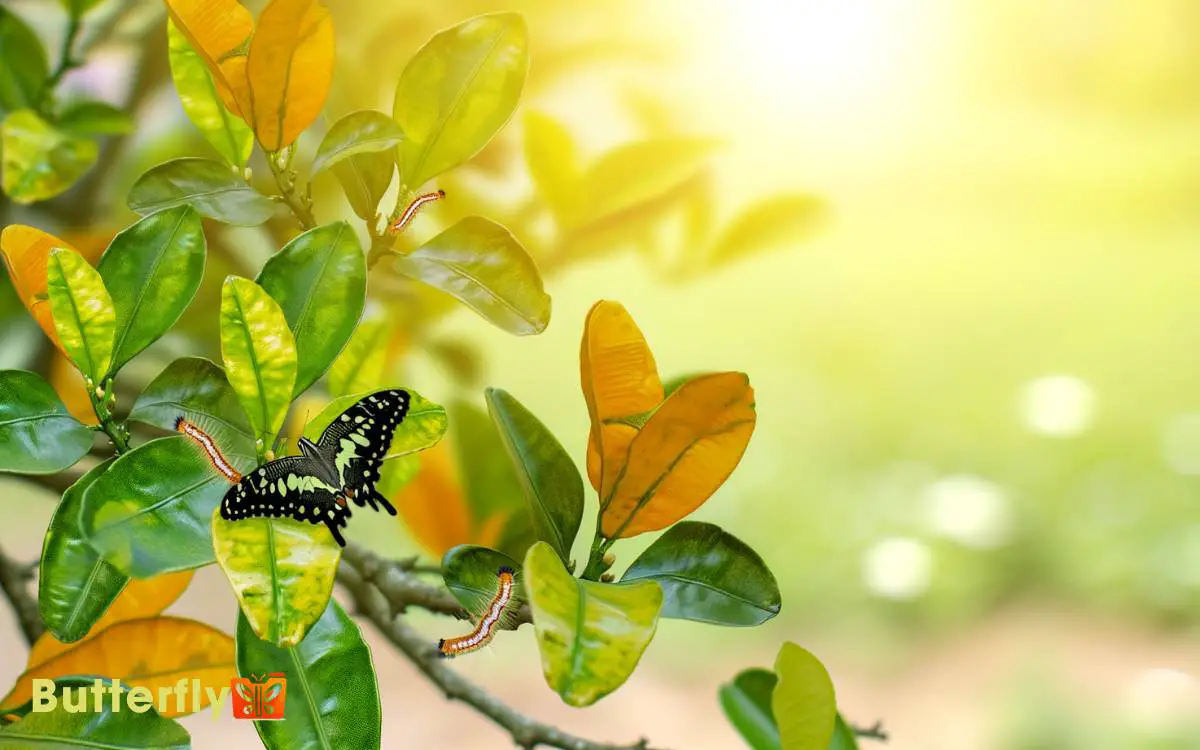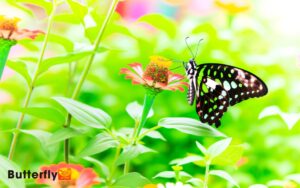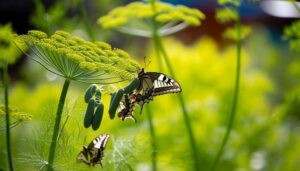Are Swallowtail Butterflies Dangerous for My Citrus? Explore
Swallowtail butterflies, particularly the larvae, can indeed pose a threat to citrus plants by feeding on their tender leaves.
The larvae, identified by their vibrant green bodies with eye-like spots, primarily consume foliage from plants in the Rutaceae family, which includes citrus species.Their selective feeding patterns target the nutrient-dense parts of the leaves, potentially hindering plant growth.
Nonetheless, swallowtails aid in pollination and serve as bioindicators of environmental health. Effective management strategies, like using neem oil and introducing natural predators, can minimize their impact.
For those interested, additional details on preventive measures and benefits are available.

Key Takeaways
Understanding Swallowtail Butterflies
Swallowtail butterflies, belonging to the Papilionidae family, exhibit distinct coloration and wing patterns that aid in their identification and study.
These butterflies display a variety of hues, often featuring bright yellows, greens, and blues, combined with black markings. Their tails, resembling a swallow’s, serve as a key identification feature.
Observations indicate that these patterns may play a role in predator avoidance through mimicry and camouflage. Additionally, the presence of eyespots on their wings can deter potential threats by mimicking the eyes of larger animals.
Life Cycle of Swallowtails
The life cycle of swallowtails comprises four distinct stages: egg, larva, pupa, and adult, each contributing to their development and ecological role.
Eggs are laid individually on host plants, ensuring the larvae’s immediate food source. Once hatched, the larva, also known as a caterpillar, undergoes several molts, consuming foliage to fuel its growth.
The pupa stage, or chrysalis, involves metamorphosis within a protective casing, transforming the larva into an adult butterfly.
| Stage | Duration | Key Activity |
|---|---|---|
| Egg | 4-10 days | Hatching |
| Larva | 2-4 weeks | Feeding and growth |
| Pupa | 1-2 weeks | Metamorphosis |
The adult butterfly emerges, ready to reproduce, continuing the cycle.
Identification of Swallowtail Larvae
Swallowtail larvae exhibit distinct appearance and color patterns that vary across their developmental stages. Early instar larvae often mimic bird droppings for camouflage, while later stages present bright green bodies with eye-like spots.
Identifying these changes is essential for accurate recognition and study of the species.
Appearance and Color Patterns
Sporting a variety of vibrant hues and intricate patterns, swallowtail larvae exhibit distinctive markings that facilitate their identification.
Typically, these larvae display a combination of green, black, and yellow colors, often mimicking bird droppings in early stages to evade predators.
As they mature, patterns tend to shift, presenting eye spots and longitudinal stripes that enhance their camouflage within foliage. These markings serve as both a defense mechanism and an identifier for entomologists and gardeners.
The larvae’s bodies are segmented, with each segment showing unique coloration and texture variations. Importantly, the presence of an osmeterium, a forked gland that emits a foul-smelling chemical when threatened, is a key characteristic.
This diverse coloration and specific anatomical features make swallowtail larvae recognizable.
Growth Stages Overview
Identifying swallowtail larvae involves observing their growth stages, each marked by distinct morphological changes that aid in their recognition. Initially, larvae are small, dark, and resemble bird droppings, which provides camouflage from predators.
As they progress to later instars, their coloring shifts to green with distinctive eye spots, mimicking snake heads for protection.
The final instar exhibits a more pronounced green coloration with yellow and black markings. These changes in color and pattern are essential for accurate identification.
Additionally, the osmeterium, an organ that emits a foul odor when threatened, becomes more visible. By noting these characteristics, one can effectively identify swallowtail larvae at various stages, ensuring accurate monitoring and management of citrus plants.
Common Citrus Pests
Citrus crops often fall prey to a variety of pests, such as aphids, scale insects, and citrus leaf miners, which can have a substantial impact on their health and yield. These pests can cause significant damage through direct feeding or by acting as vectors for diseases.
The primary citrus pests include:
- Aphids: These small insects feed on sap, causing leaf curl and transmitting viruses.
- Scale Insects: These pests attach to branches and leaves, extracting sap and secreting honeydew, leading to sooty mold.
- Citrus Leaf Miners: Their larvae tunnel into leaves, creating serpentine mines that reduce photosynthetic capacity.
- Whiteflies: These insects suck sap and produce honeydew, promoting fungal growth.
Effective pest management strategies are essential to protect citrus crops.
Swallowtail Larvae Diet
Swallowtail larvae primarily feed on plants from the Rutaceae family, with citrus species being a frequent host. Their nutritional needs are met through the high nitrogen content found in these plants, which is vital for their development.
Observations indicate that the larvae exhibit distinct feeding patterns, often consuming leaves in a systematic manner to maximize nutrient intake.
Common Host Plants
Many swallowtail butterfly larvae primarily feed on host plants from the Rutaceae family, particularly those in the Citrus genus.
These larvae exhibit a preference for:
- Orange (Citrus sinensis)
- Lemon (Citrus limon)
- Grapefruit (Citrus paradisi)
- Lime (Citrus aurantiifolia)
Observations indicate that larvae selectively consume the tender leaves, occasionally causing notable defoliation. This feeding behavior can prompt concerns among citrus growers, especially in regions with high butterfly populations.
While the larvae’s impact varies, their host plant specificity largely confines them to citrus and closely related species in natural and cultivated settings.
Understanding these preferences is essential for managing potential damage and ensuring the vitality of citrus crops, aligning with the desire for sustainable and effective agricultural practices.
Nutritional Needs
The larvae of swallowtail butterflies require a diet rich in essential nutrients, which they primarily obtain from the young, tender leaves of their host plants.
These nutrients include various amino acids, carbohydrates, and essential fatty acids, important for their rapid growth and development.
Citrus plants, particularly their young shoots, provide an ideal nutritional profile for swallowtail larvae. Scientific observations indicate that these larvae exhibit a preference for citrus leaves due to their high nitrogen content, which supports protein synthesis.
Additionally, the moisture content in tender leaves aids in hydration, ensuring efficient metabolic processes.
Feeding Patterns
Building on their need for nutrient-rich diets, larvae exhibit distinct feeding patterns that maximize nutrient intake from young citrus leaves. They selectively consume the most tender and nutrient-dense parts of the foliage.
Observations indicate that these feeding patterns follow a predictable sequence:
- Initial Feeding: Larvae begin by consuming the peripheral edges of the leaves.
- Midrib Consumption: They then proceed to eat along the midrib, ensuring structural integrity while maximizing intake.
- Leaf Skeletonization: Following this, larvae skeletonize the leaves, leaving only veins intact.
- Leaf Drop: Finally, mature larvae may consume entire leaves, causing them to drop.
These systematic feeding behaviors enable larvae to optimize nutrient absorption, essential for their growth and development, while strategically minimizing waste.
Damage to Citrus Trees
Despite their striking beauty, swallowtail butterflies can inflict significant damage on citrus trees by laying eggs that hatch into voracious larvae. These larvae, also known as caterpillars, feed aggressively on the foliage, often stripping leaves down to the veins.
Such defoliation can weaken young trees, reducing their photosynthetic capacity and overall vigor. In severe infestations, the larvae can even damage the tree’s structural integrity by gnawing on tender shoots and branches.
Citrus growers should monitor for the presence of swallowtail larvae, particularly during peak breeding seasons. Early detection and management are essential to minimizing damage and ensuring the health and productivity of citrus orchards.
Careful observation and timely intervention can help mitigate the impact of these larvae on citrus trees.
Beneficial Roles of Swallowtails
In addition to their role as pollinators, swallowtail butterflies contribute to biodiversity by serving as a food source for various predators.
These butterflies play several beneficial roles within ecosystems:
- Pollination: Swallowtails help in the cross-pollination of numerous flowering plants, aiding in plant reproduction and genetic diversity.
- Food Web Dynamics: As prey, they support birds, spiders, and small mammals, maintaining balanced food webs.
- Indicator Species: Swallowtails act as bioindicators, reflecting the health of their habitats and signaling environmental changes.
- Cultural Significance: They captivate humans with their beauty, fostering appreciation for nature and promoting conservation efforts.
Natural Predators
Swallowtail butterflies face significant predation pressure from various natural enemies. Birds frequently prey on both the larvae and adult stages, exploiting their visibility and abundance. Some species have evolved defense mechanisms, such as mimicry and toxic chemical compounds, to reduce their vulnerability. The tiger swallowtail butterfly significance lies in its role as both a pollinator and a prey species, contributing to ecosystem balance. Despite these adaptations, habitat loss and climate change further exacerbate the challenges they face in survival.
Additionally, parasitoid wasps target swallowtail caterpillars, laying eggs that eventually consume the host from within, thereby regulating their population.
Birds as Predators
Importantly, various bird species, such as the American robin and the blue jay, are known to be significant predators of swallowtail butterflies. These birds actively seek out both larvae and adult butterflies, contributing to natural population control.
Observations reveal that birds employ various strategies to capture and consume these insects.
For instance, birds often:
- Hunt visually: Spotting brightly colored swallowtails amidst foliage.
- Use sharp beaks: Efficiently capturing and puncturing butterflies.
- Take advantage of flight: Chasing and catching butterflies mid-air.
- Employ stealth: Approaching slowly to minimize prey escape.
These predatory behaviors ensure that swallowtail populations are kept in check, thereby indirectly protecting citrus plants from potential over-infestation.
This natural predation is essential for maintaining ecological balance.
Parasitoid Wasps
Beyond avian predators, parasitoid wasps play a significant role in controlling swallowtail butterfly populations by laying their eggs inside or on larvae, which eventually leads to the host’s death.
These wasps exhibit remarkable specificity and efficiency, targeting swallowtail caterpillars with precision.
Upon hatching, the wasp larvae consume the host from within, disrupting its development and ultimately causing mortality. This natural control mechanism profoundly impacts swallowtail populations, reducing potential damage to citrus plants.
Field observations and studies highlight the wasps’ effectiveness, demonstrating their beneficial role in integrated pest management.
By leveraging these natural predators, gardeners and farmers can maintain healthier citrus crops without relying heavily on chemical interventions.
This method aligns with sustainable agricultural practices, promoting ecological balance.
Preventive Measures
To secure damage caused by Swallowtail butterflies, gardeners can implement several preventive measures to protect citrus plants. Observing the life cycle and behaviors of these butterflies assists in timely interventions.
- Physical Barriers: Use fine mesh netting to cover young citrus trees, preventing adult butterflies from laying eggs.
- Companion Planting: Planting strong-scented herbs like dill and fennel around citrus trees can deter butterflies.
- Regular Monitoring: Inspect leaves frequently for eggs and larvae, removing them manually if found.
- Healthy Soil: Maintaining nutrient-rich, well-drained soil enhances plant resilience against potential infestations.
Employing these measures secures a proactive approach, minimizing the likelihood of significant damage while promoting the health and vigor of citrus plants.
Organic Control Methods
Organic control methods offer effective, eco-friendly solutions for managing Swallowtail butterfly infestations on citrus plants.
Neem oil acts as an insect growth regulator, disrupting the larvae’s development without harming beneficial insects.
Bacillus thuringiensis (Bt), a naturally occurring bacterium, targets caterpillars specifically, ensuring minimal impact on non-target species.
Handpicking larvae can be a labor-intensive yet precise method, allowing gardeners to maintain direct control over the population.
Introducing natural predators like ladybugs and lacewings also provides biological control by preying on Swallowtail larvae.
Additionally, planting companion herbs such as dill and fennel can attract butterflies away from citrus plants.
Encouraging Biodiversity
Integrating biodiversity into citrus orchards enhances ecosystem resilience, ensuring natural pest control and improved plant health. Diverse plant and animal species contribute to a balanced ecosystem by promoting beneficial insects and reducing pest populations.
Implementing biodiversity can be approached through several strategies:
- Planting cover crops: These provide habitats for beneficial insects and improve soil health.
- Introducing native plants: These support local wildlife and attract pollinators.
- Establishing hedgerows: These act as windbreaks and offer shelter for various species.
- Providing water sources: Ponds or water features attract birds and insects, enhancing ecological interactions.
These practices not only foster a healthier orchard but also empower growers with sustainable and natural solutions, reducing dependency on chemical interventions.
Conclusion
While swallowtail butterflies add a touch of Eden to any garden, their larvae can pose a threat to citrus plants. By understanding their life cycle and identifying larvae, gardeners can mitigate damage.
Natural predators and organic control methods offer effective solutions. Encouraging biodiversity, reminiscent of Darwin’s observations, can maintain ecological balance.
Therefore, with informed strategies, one can protect their citrus while still marveling at the beauty of these butterflies.






